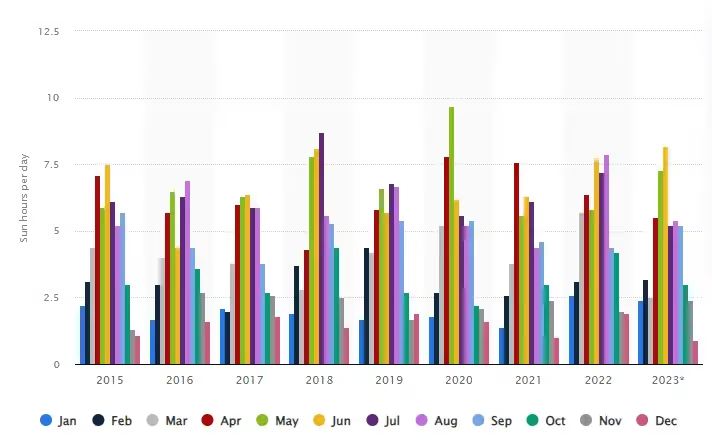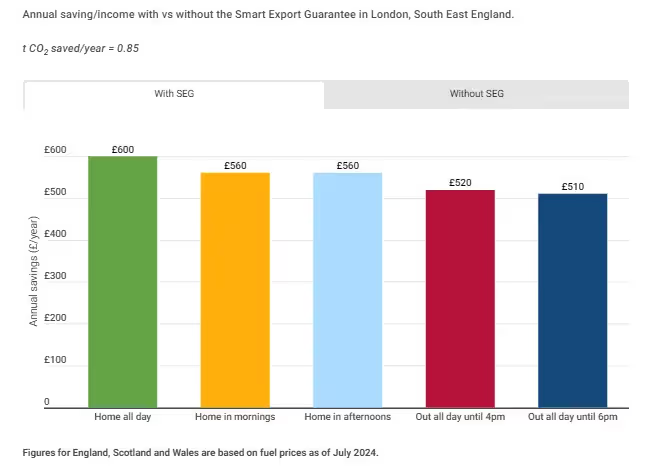
This is a detailed 10-minute guide. Stuck for time? Read our quick-fire summary covering how many solar panels you need instead, and bookmark this page for later…
A typical 3-bedroom house will need 10 solar panels. This is based on electricity consumption that is “average”, approximately 2,700kWh per annum.
The total installation cost of a 10 panel setup without a battery is likely to be somewhere in the region of £7,000-£9,000.
That said, how many solar panels you need and the overall cost will be determined by:
Solar batteries are an important component for those that want to be self-sufficient. Given their expense, it’s worth taking the time to determine exactly which size battery you need.
Alternatively, any excess electricity your solar panels produce you can sell back to the grid via the Smart Export Guarantee.
Want to figure out exactly how many solar panels you need?
Use our solar panel calculator here. It will analyse your roof, estimate electricity usage and suggest the most suitable solar panel setup. It will also highlight potential energy savings (£600 per year for the average property in the UK).

There are dozens of factors that affect exactly how many solar panels you need. These include the likes of:
- Average monthly electricity consumption
- Directionality of your roof
- Output and efficiency of your solar panels
- Hours of sunlight in a day that your roof gets
- How big your roof is and its weight capacityThe list goes on and on…!
However, if you’re looking for an estimate based on average electricity consumption in the UK, this is how many solar panels you’re likely to need:
In the example above, a system with 10 solar panels is the most common setup for a 3-bedroom semi-detached house in the UK, whereas you’d need 13 panels or more for a 5-bedroom detached.
However, it’s worth noting that if you don’t have a solar battery, a lot of the electricity you generate may go to waste. A solar panel setup that doesn’t use a battery can’t store electricity, so if at any point you generate more than you are using, it’s wasted.
If you want to utilise wasted energy, you have two options:
If you’ve heard of “selling electricity back to the grid”, in general, this refers to the Smart Export Guarantee. This programme is designed to utilise solar energy that would otherwise go to waste, as well as encourage UK households to adopt low-carbon energy solutions.
Put simply? You’ll get paid for any electricity you’re able to pass back to the grid, helping to offset the cost of your solar panel installation costs.
Working out exactly how many solar panels you need isn’t a one size fits all approach. Use our solar panel calculator to determine exactly how many panels you need, and how much your installation is going to cost.
Everything from your households’ electricity consumption to hours of sunlight per day where you live, have a bearing on how many solar panels you need.
Below, we’ll explore the most important factors that affect how big your solar panel system needs to be.
Step 1? Work out exactly how much electricity your household consumes annually. You can do this by:
It’s important to get data on your electricity usage for a full year.
You’ll use much more/less energy at certain parts of the year depending on dozens of factors including; type of heating and insulation, how much time you spend indoors and how many people are in your household.
If you don’t have your smart meter readings or energy bills to hand, below are the average figures for electricity usage in the UK, based on property size:

How many solar panels you’ll need for your property will depend on both the size and efficiency of the panels you’re going to install.
First, we have output (or, size).
A typical solar panel is 250w-400w. Naturally, the higher the output of a solar panel (assuming the same efficiency), the less you’re going to need. 13 x 250w panels would have a maximum output of 3,250 kWh, whilst 13 x 400w solar panels would have a maximum output of 5,200 kWh!
In terms of efficiency, you should expect that to be in the region of 20%. A 250w panel at 100% efficiency would produce 3kWh of electricity per day. Due to its efficiency level of 20%, you’d expect it to actually produce 600w of electricity.
In summary, different brands / models of solar panels have different levels of efficiency and output. And that’s going to affect exactly how many solar panels you need for your property.
Most people aim to buy a property with a south facing garden for one simple reason; maximum sunlight.
If you have a south facing roof on the front or rear of your property, this is perfect in terms of solar panel efficiency. Even more so if the pitch of the roof is approximately 35 degrees.
These conditions allow a system to work at maximum efficiency, reducing the number of solar panels you need (and your overall installation cost).
Our tool here can analyse your roof to determine efficiency, and approximate annual savings on your energy bills.
Depending on your roof’s structure and capacity, you may be limited on how many solar panels you can install on it.
The condition of the roof and its structure is the first limitation. Each solar panel is likely to weigh around 20kg. For a larger system using 12+ solar panels, you’re looking at nearing 250kg in total; your roof needs to be in good condition to have this kind of weight on it.
An MCS installer will need to assess your roof’s condition to determine whether or not it can support this additional weight.
Other limitations come in the form of chimneys, or even the flue for your boiler (if it comes out vertically via the roof). Solar panels won’t be able to be fitted on these parts of the roof and that limits the amount of panels you’ll be able to install.
We’re not exactly blessed in the UK when it comes to average daily sunlight hours. Typically, we get around 4.9 hours on average throughout the year.

However, where you live has some bearing on how many solar panels you need. For example, the Isle of Wight has approximately 5 hours 9 minutes of daily sunlight on average, whereas Cornwall gets 4 hours 29 minutes.
This might not seem like a massive difference, but it is. The sunlight hours in the Isle of Wight are approximately 13% more than Cornwall (which is considered reasonably sunny in its own right).
Put simply, you’d need 13% more output from your solar panel system in Cornwall, to match the production of a solar panel system in the Isle of Wight. Another way of looking at it is a system with 11-12 panels for a property based in Cornwall, could be matched by a 10 panel system in the Isle of Wight.
Other factors that affect how much sunlight your solar panels get per day include anything that could cause a blockage such as: neighbouring properties, hedges and trees.
Depending on their location, they could knock an hour or two from the total daily hours of sunlight your solar panels get.
To make the most out of your solar panels, you’ll want a battery. Without one, any electricity you produce that isn’t used instantly, will go to waste (unless you sell it back to the grid using the Smart Export Guarantee).
Solar panel batteries are extremely expensive, you could be paying up to £5,000 for a 5kWh unit depending on the brand and model. And that’s why it’s important to ensure you’re picking the right size.
Choosing a solar battery that’s too small will mean your solar panels produce electricity that goes to waste. A battery that’s too big? You’ll have spent extra money for nothing.
To decide on the correct battery size, you first need to ensure your solar panel system is producing excess electricity (easily done via the app that comes with your solar panel installation). If it is, you simply need to determine your daily electricity that you’re paying for (from the grid), and get a battery that’s slightly bigger than this kWh figure.
So, if it's 1kWh per day of electricity you’re having to pay for from the grid, you’ll need a battery that’s just slightly bigger; 2kWh.
A small 4kWh solar panel system is one of the most commonly installed in the UK, with average installation costs sitting in the region of £7,000.
According to the Energy Saving Trust, installing solar panels on an average property in the UK would save up to £600. So, not only is this an eco-friendly way to generate electricity, it’s cost effective too!

This is an estimate, and depending on your property size and electricity consumption, you may need a smaller / larger setup, and a solar battery.
A solar battery allows consumers to make the most out of their setup by storing electricity they generate during daylight hours, ready for use at night. However, choosing the right battery is important, given they cost thousands of pounds.
Use our tool here to determine exactly what size solar panel system you need and exactly how much it will cost.
Try our free quote tool. You'll have your personalised quote in under a minute.